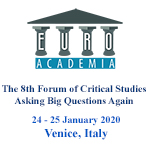Euroacademia Conferences
 Europe Inside-Out: Europe and Europeanness Exposed to Plural Observers (9th Edition) April 24 - 25, 2020
Europe Inside-Out: Europe and Europeanness Exposed to Plural Observers (9th Edition) April 24 - 25, 2020 Identities and Identifications: Politicized Uses of Collective Identities (9th Edition) June 12 - 13, 2020
Identities and Identifications: Politicized Uses of Collective Identities (9th Edition) June 12 - 13, 2020 8th Forum of Critical Studies: Asking Big Questions Again January 24 - 25, 2020
8th Forum of Critical Studies: Asking Big Questions Again January 24 - 25, 2020 Re-Inventing Eastern Europe (7th Edition) December 13 - 14, 2019
Re-Inventing Eastern Europe (7th Edition) December 13 - 14, 2019 The European Union and the Politicization of Europe (8th Edition) October 25 - 26, 2019
The European Union and the Politicization of Europe (8th Edition) October 25 - 26, 2019 Identities and Identifications: Politicized Uses of Collective Identities (8th Edition) June 28 - 29, 2019
Identities and Identifications: Politicized Uses of Collective Identities (8th Edition) June 28 - 29, 2019 The European Union and the Politicization of Europe (7th Edition) January 25 - 26, 2019
The European Union and the Politicization of Europe (7th Edition) January 25 - 26, 2019 7th Forum of Critical Studies: Asking Big Questions Again November 23 - 24, 2018
7th Forum of Critical Studies: Asking Big Questions Again November 23 - 24, 2018 Europe Inside-Out: Europe and Europeanness Exposed to Plural Observers (8th Edition) September 28 - 30, 2018
Europe Inside-Out: Europe and Europeanness Exposed to Plural Observers (8th Edition) September 28 - 30, 2018 Identities and Identifications: Politicized Uses of Collective Identities (7th Edition) June 14 - 15, 2018
Identities and Identifications: Politicized Uses of Collective Identities (7th Edition) June 14 - 15, 2018
Are Some People More Equal than Others? Experimental Evidence on Group Identity and Income Inequality
-
-

-
Presentation speakers
- Joep Lustenhouwer, University of Bamberg, Germany
- Tomasz Makarewicz, University of Bamberg, Germany
- Juan Carlos Peña, University of Bamberg, Germany
- Christian R. Proaño, University of Bamberg, Germany
Abstract:
Motivation
The political debate in the recent decade has shifted towards the issues of income inequality and immigration. It has been argued that both factors contribute to the increasing polarization of politics and rise of extreme parties, but it is difficult to disentangle their individual effects, since they typically appear simultaneously. An important example is Brexit. The polls showed that the immigration was the most important argument for Leavers, but their specific motivation remains unclear: was it a straightforward dislike of the “aliens”, or an economic anxiety that these “aliens” will take over jobs and social safety programs? In other words, would the backlash have happened if the economic inequality was smaller or absent? And would it have happened if the new migrants were to a smaller degree considered as “alien”? A similar question can be asked about Trump voters or EU citizens who opposed the influx of refugees in 2015.
Research questions
1. Are people selfish in their insurance choices?
2. Are people motivated by the like or dislike of the “other” even if it has no discernible impact on the income?
3. Is there a potential feedback effect these two?
Political Experiment
In such a laboratory experiment we are able to elicit opinions and preferences for different political schemes in a controlled environment. This gives us the unique opportunity to isolate the effects of group identity from that of monetary incentives on political polarization and willingness for social sharing. There are 28 subjects in each session (optimized to the size of our laboratory). During the experiment, they will play repeatedly a variant of a public good game for T = 25 periods. In each period t, the subjects will be randomly split into groups of seven. The composition of the group of seven participants will change during the experiment, but its size will remain fixed. Furthermore, all participants are of one of two different types: green and lilac. We consider a simple 2 by 2 design. On one dimension, they are either given the information that subjects have different colors (Color), or not (Gray). On the other dimension, they either only know their own probability and the range in which all probabilities of other subjects must lie (Equality), or they know the exact probability that each other subject in their group has gotten (Inequality). -
Related Presentations













